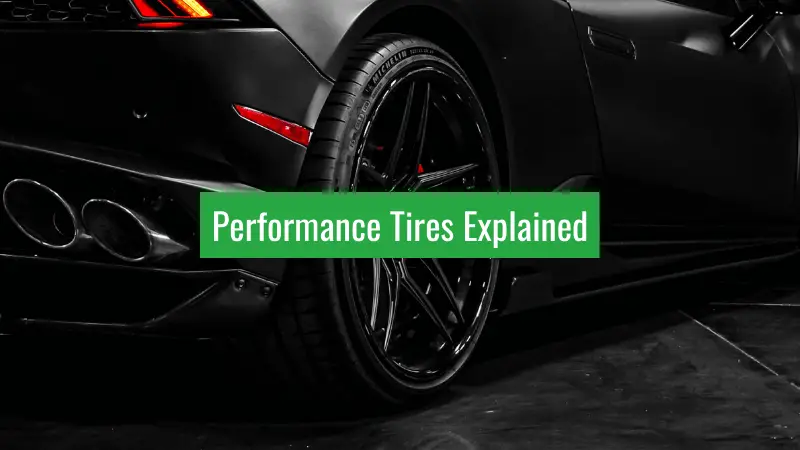Performance tires are a crucial component for those who seek an exhilarating driving experience, offering increased handling response and traction, especially in wet or dry conditions.
As the vehicle owner, your decision to use performance tires can greatly enhance your sports car or high-performance vehicle’s overall performance, and in this article, we will explain the key features and benefits of these specialized tires.
For drivers like yourself, choosing the right tires can make a significant difference in handling, road grip, and driving pleasure. Performance tires deliver precisely what you’re looking for: improved traction, steering response, and cornering abilities.
Typically designed for use in dry and damp conditions, these tires provide balance between longevity and handling performance, suitable for use in autocross events or track driving.
Not all performance tires are created equal, so it’s crucial for you to understand the different levels of performance available, including ultra-high performance options designed for extreme high speeds and traction levels.
By considering the characteristics, capabilities, and intended use of performance tires, you will be able to select the best choice for your specific driving preferences and vehicle requirements.
Types of Performance Tires
When looking for performance tires to improve your vehicle’s handling and grip, you’ll come across several types, each designed to cater to specific driving needs and preferences.
In this section, we’ll discuss the main types of performance tires:
Max Performance
Max performance tires offer a high level of grip and precision handling, making them suitable for high-end sports cars and performance sedans. They feature advanced rubber compounds and aggressive tread patterns to provide excellent traction on dry and wet surfaces.
While these tires stand out in terms of performance, their durability and comfort might not be as impressive.
Ultra High Performance
Ultra high performance tires are a notch below max performance tires, but they still deliver an excellent balance of grip, handling, and ride quality. They cater to drivers looking for enhanced road feedback and cornering stability.
Ultra high performance tires are available for both summer and all-season driving conditions, ensuring you can find a suitable option for your specific needs.
Extreme Performance
As the name suggests, extreme performance tires offer exceptional grip levels and are designed for drivers who want the most out of their cars. These tires often use compounds inspired by racing technology and feature the most aggressive tread patterns.
While they provide outstanding performance on the track, their comfort and durability on regular roads might be compromised.
Track Day
Track day tires are specifically designed for use during track events or competitive driving. They have unique rubber compounds and tread designs that provide ultimate grip on racetracks.
However, track day tires are not ideal for everyday driving, as they often have limited tread life and may not perform well in wet conditions or provide the most comfortable ride.
Consider your driving preferences, desired performance attributes, and the conditions under which you’ll be using the tires when selecting the right type of performance tire for your vehicle.
Performance Tire Comparisons

When it comes to choosing performance tires for your vehicle, it’s important to understand the differences between the three main types: summer, all-season, and winter tires. Afterall, performance tires are made for each of these tire types.
In this section, we’ll compare these categories to help you make an informed decision based on your specific driving needs.
Summer Tires
Summer tires are designed for optimal performance in warmer temperatures and dry road conditions. They provide excellent grip, precise handling, and shorter braking distances. However, they are not suitable for cold weather or snowy conditions.
Some notable features of summer tires include:
- Soft rubber compound for better grip
- Unique tread patterns for efficient water evacuation
All-Season Tires
All-season tires are a versatile option, designed to provide satisfactory performance in various weather conditions. While they may not perform as optimally as summer or winter tires in their respective conditions, they offer a suitable balance for drivers who experience mild climate changes throughout the year.
Characteristics of all-season tires include:
- Medium hardness rubber compound
- Tread patterns designed for wet and dry roads
- Moderate snow traction
Winter Tires
Winter tires, also known as snow tires, are designed specifically for cold temperatures and snowy or icy conditions. They provide optimal traction, handling, and braking performance in harsh winter weather, ensuring a safer driving experience.
Key features of winter tires are:
- Soft rubber compound that remains flexible in low temperatures
- Deep tread patterns for improved snow and ice grip
- Sipes and grooves to channel water and slush away from the contact patch
By understanding the differences between summer, all-season, and winter tires, you are better equipped to choose the right performance tires for your vehicle and your driving needs.
Tread Pattern and Lifespan of Performance Tires

Tread Pattern
Understanding the tread pattern of performance tires is crucial for getting the most out of your driving experience. Tread patterns are unique designs that enhance grip and handling for specific driving conditions.
Performance tires typically have a more aggressive tread pattern, designed to provide optimal grip and traction during high-speed driving or cornering. There are a few common types of tread patterns:
- Symmetrical – These patterns have a similar design on both sides of the tire, making them easy to rotate and extend their lifespan. However, they’re not ideal for wet and slippery conditions.
- Directional – These patterns have a V-shape and point in one direction, providing excellent grip and traction in wet and snowy conditions.
Lifespan
The lifespan of your performance tires depends on various factors, such as driving habits, road conditions, and tire maintenance. Regularly checking tire pressure, inspecting tread depth, and rotating your tires are essential practices that can extend their life and performance.
It is important to note that performance tires may have a shorter lifespan compared to standard all-season tires. This is primarily due to the softer rubber compounds used to maximize grip and handling, which can wear down faster.
Family-car tires can readily last 70,000 miles or more, while performance tires may require replacement sooner.
Tread Wear
Tread wear refers to the rate at which a tire loses its tread over time. Government-required tread wear grades provide an estimate of how well a tire is expected to wear. For example, a tire with a tread wear grade of 300 will wear three times as well as a tire graded 100.
Keep in mind that these grades are only estimates and actual tread life may vary depending on factors such as driving habits, road conditions, and tire maintenance practices. Monitoring your tire’s condition and addressing any wear-and-tear issues early can help you maximize the tread life of your performance tires.
Handling and Grip of Performance Tires
Performance tires are designed to provide superior handling and grip, which improves your driving experience. This section will cover the key aspects of how these tires enhance acceleration and braking, cornering and stability, and traction on different surfaces.
Acceleration and Braking
One of the main reasons you should consider using performance tires is their ability to deliver better acceleration and braking capabilities. With their sticky compound, these tires have a greater grip on the road, allowing you to accelerate quickly and stop more effectively.
Enhanced braking performance is particularly important when driving at high speeds or during sudden stops. Performance tires can improve your overall safety, especially in challenging driving situations.
Cornering and Stability
Performance tires are not just about acceleration and braking; they also enhance cornering and stability. The stiffer sidewalls and wider tread make it easier for you to navigate corners confidently.
Furthermore, the structural design of these tires ensures that their contact patch with the road remains consistent during cornering, leading to more predictable and controlled turns. This is particularly beneficial when driving on winding roads or in high-performance vehicles.
Traction on Different Surfaces
Different performance tires cater to varied driving conditions. When it comes to traction, you’ll find options for dry, wet, and even snowy surfaces. These tires feature specialized tread patterns and unique compounds that improve grip and handling across various road conditions.
It’s crucial to choose the right type of performance tire for your specific needs, as using the wrong tire could compromise your vehicle’s handling and safety. Remember to consult your vehicle’s manufacturer guidelines or speak with a professional before making your selection.
Selecting the Right Performance Tire for Your Vehicle

When it comes to choosing performance tires for your vehicle, there are several factors you should consider. These factors include your vehicle type, driving conditions, budget, and personal preferences.
By considering all of these aspects, you can make an informed decision and find the best tire for your needs.
Vehicle Type
Your vehicle type plays a crucial role in selecting the right tire. The requirements for sports cars, SUVs, and family sedans may vary greatly.
For a sports car, you may want to opt for performance summer tires that offer exceptional grip and handling on both dry and wet roads. For SUVs or other larger vehicles, you may need all-season or all-terrain tires that provide adequate traction and durability in various conditions.
In the case of a family sedan, touring all-season tires would be a suitable option, as they offer a balance between performance, comfort, and longevity.
Driving Conditions
The driving conditions you frequently encounter also play a significant role in your tire selection. If you live in an area with heavy snowfall or icy roads, you should consider winter or snow tires. These tires have a specific tread design and rubber compound that provide better traction on snowy and icy roads.
For those living in warmer climates, summer or all-season tires may be better suited to handle the predominantly dry roads or occasional rain showers.
Budget
When selecting performance tires, it’s essential to consider your budget. You may want to opt for tires with increased longevity if you are on a tighter budget, as they will require less frequent replacement.
Keep in mind that low-cost tires may not provide the same level of grip or handling as their more expensive counterparts. It would be best to find a balance between your budget and your desired performance characteristics.
Be sure to pay attention to the tire label as well, which contains important information on tire size and load index. This will help you find a tire that fits your vehicle’s specifications and meets its weight and load requirements.
Preference
Finally, consider your personal preferences when choosing performance tires. Some drivers may prioritize comfort and a smooth ride, whereas others may focus on grip and handling.
There’s no one-size-fits-all tire, so take the time to assess your priorities and choose a tire that best fits your desired driving experience.
Where to Buy Performance Tires
When it comes to purchasing performance tires for your vehicle, there are various options available to you. In this section, we will discuss the advantages and general information related to buying from online retailers, local dealerships, and shops.
Online Retailers
Online retailers offer a wide selection of performance tires from different brands, often at competitive prices. Popular online retailers like Tire Rack, Discount Tire and even Amazon provide detailed information and reviews that can help you make an informed decision.
Additionally, shopping online allows you to compare prices and specifications easily. However, keep in mind that you may need to arrange for installation separately, either by a local shop or an installation partner provided by the online retailer.
Local Dealerships and Shops
Purchasing performance tires from your local dealership or tire shop has the advantage of personalized service and expert advice. The sales representatives can help you choose the right performance tires for your specific make and model, taking into consideration your driving needs and preferences.
Moreover, local shops often provide comprehensive service, which means that they will not only sell you the tires but also mount and balance them on your vehicle.
Some of the benefits of buying from a local dealership or shop include:
- Personalized service from knowledgeable professionals
- Hands-on assistance with your tire selection
- Complementary tire installation services
In conclusion, whether you choose to purchase performance tires from an online retailer or a local dealership or shop, it is essential to research and compare the available options to make the best decision for your needs.
Remember that the primary goal is to enhance your vehicle’s handling and overall driving experience by selecting high-quality performance tires.
Hi, my name is Niklas, the head content creator & CEO of Whirling Wheelz. I am very interested in vehicles of all kinds, mainly cars. I have a car mechanics degree from high school and a big hobby of mine is to follow the WRC (World Rally Championship) both online and through travel.


